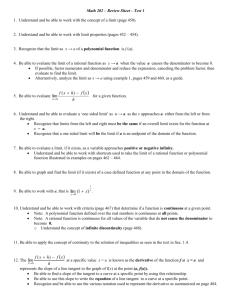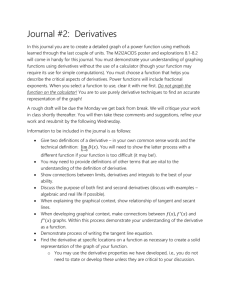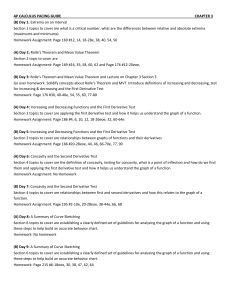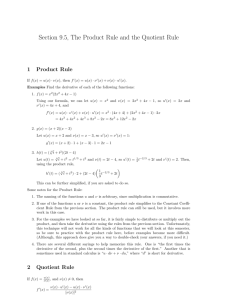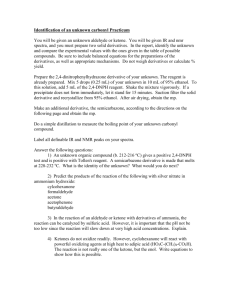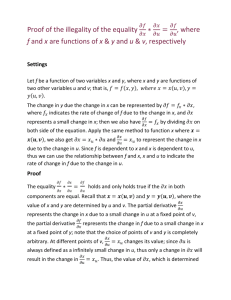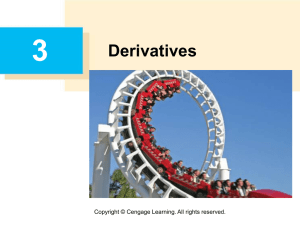Lesson 10.5: Basic Differentiation Properties
advertisement
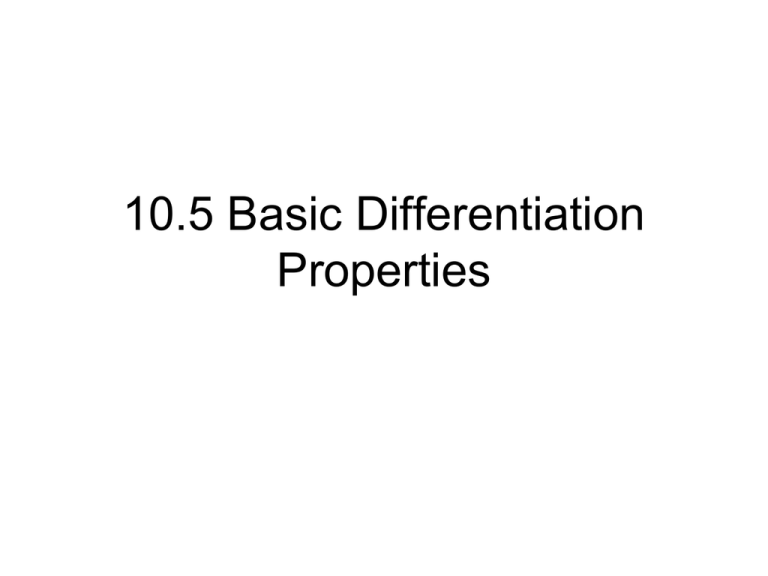
10.5 Basic Differentiation Properties 10.5 Basic Differentiation Properties • Instead of finding the limit of the different quotient to obtain the derivative of a function, we can use the rules of differentiation (shortcuts to find the derivatives). Review: Derivative Notation There are several widely used symbols to represent the derivative. Given y = f (x), the derivative may be represented by any of the following: ■ f ’(x) ■ y’ ■ dy/dx What is the slope of a constant function? The graph of f (x) = C is a horizontal line with slope 0, so we would expect f ’(x) = 0. Theorem 1. Let y = f (x) = C be a constant function, then y’ = f ’(x) = 0. Examples: Find the derivatives of the following functions 1) f(x) = -24 f’(x) = ? 0 2) f(x) = 7 f’(x) = ? 0 3) f(x) = π f’(x) = ? 0 Power Rule A function of the form f (x) = xn is called a power function. This includes f (x) = x (where n = 1) and radical functions (fractional n). Theorem 2. (Power Rule) Let y = xn be a power function, then y’ = f ’(x) = n xn – 1. Example Differentiate f (x) = x10. Solution: By the power rule, the derivative of xn is n xn–1. In our case n = 10, so we get f ’(x) = 10 x10-1 = 10 x9 Example Differentiate f ( x) 3 x. Solution: Rewrite f (x) as a power function, and apply the power rule: f ( x) x 1/ 3 1 2 / 3 1 f ' ( x) x 2 3 3 3 x Examples: Find the derivatives of the following functions 1) x6 f(x) = f’(x) = ? 4) f(x) = 6x5 2) f(x) = t-2 f’(x) = ? -2t-3= 3) f(x) = f’(x) = 2 t3 5) f(x) = ? 3 u2 3 t 2 1 2 1x 2 1 2 x = u2/3 2 3 2 u 1/ 3 3 3u 6) f(x) = 1 x f’(x) =? = x-1 1 f’(x) =? t3/2 f’(x) = ? 1 x = x-1/2 3 1 1 x 2 3/ 2 2 2x Constant Multiple Property Theorem 3. Let y = f (x) = k u(x) be a constant k times a function u(x). Then y’ = f ’(x) = k u’(x). In words: The derivative of a constant times a function is the constant times the derivative of the function. Example Differentiate f (x) = 10x3. Solution: Apply the constant multiple property and the power rule. f ’(x) = 10(3x2) = 30 x2 Examples: Find the derivatives of the following functions 1) f(x) = 4x5 f’(x) = ? 20x4 4) f(x) = t4 12 f’(x) = 1 t 3 3 1 3 2) f(x) = 1 x 3 3x 3 f’(x) = ? 1 4 1x 4 x 1 0 .9 0.9 5) f(x) = 3 1 0.9 x 3 x 3 x f’(x) = 0.3x 4 3 3 10x 4 / 3 Sum and Difference Properties Theorem 5. If y = f (x) = u(x) ± v(x), then y’ = f ’(x) = u’(x) ± v’(x). In words: ■ The derivative of the sum of two differentiable functions is the sum of the derivatives. ■ The derivative of the difference of two differentiable functions is the difference of the derivatives. Example Differentiate f (x) = 3x5 + x4 – 2x3 + 5x2 – 7x + 4. Solution: Apply the sum and difference rules, as well as the constant multiple property and the power rule. f ’(x) = 15x4 + 4x3 – 6x2 + 10x – 7. Examples: Find the derivatives of the following functions 1) 3x4-2x3+x2-5x+7 f(x) = f’(x) = ? 12x 6 x 2 x 5 3 2 2) f(x) = 3 - 7x -2 f’(x) = ? 14 14 x 3 x 3 4) f(x) = 5v f’(x) =? 3 v 5v v 4 3 1 3 / 4 1 2 15v v 15v 3 / 4 4 4v 2 3 4 x4 3 5) f(x) = 4x x 8 4 3 1 x x 4 x 3 4 8 3 2 1 3 4 f’(x) =? 4 x 12 x 2 x 3 12 1 3 4 x 2 4x x 2 1/ 4 Applications Remember that the derivative gives the instantaneous rate of change of the function with respect to x. That might be: ■ Instantaneous velocity. ■ Tangent line slope at a point on the curve of the function. ■ Marginal Cost. If C(x) is the cost function, that is, the total cost of producing x items, then C’(x) approximates the cost of producing one more item at a production level of x items. C’(x) is called the marginal cost. Example: application Let f (x) = x4 - 8x3 + 7 (a) Find f ’(x) (b) Find the equation of the tangent line at x = 1 (c) Find the values of x where the tangent line is horizontal Solution: a) f ’(x) = 4x3 - 24x2 b) Slope: f ’(1) = 4(1) - 24(1) = -20 Point: (1, 0) y = mx + b 0 = -20(1) + b 20 = b So the equation is y = -20x + 20 c) Since a horizontal line has the slope of 0, we must solve f’(x)=0 for x 4x3 - 24x2 = 0 4x2 (x – 6) = 0 So x = 0 or x = 6 Example: more application The total cost (in dollars) of producing x radios per day is C(x) = 1000 + 100x – 0.5x2 for 0 ≤ x ≤ 100. 1. Find the marginal cost at a production level of radios. Solution: C’(x) = 100 – x 2) Find the marginal cost at a production level of 80 radios and interpret the result. Solution: The marginal cost is C’(80) = 100 – 80 = $20 It costs $20 to produce the next radio (the 81st radio) 3) Find the actual cost of producing the 81st radio and compare this with the marginal cost. Solution: The actual cost of the 81st radio will be C(81) – C(80) = $5819.50 – $5800 = $19.50. Summary • If f (x) = C, then f ’(x) = 0 • If f (x) = xn, then f ’(x) = n xn-1 • If f (x) = k xn then f ’ (x) = kn xn-1 • If f (x) = u(x) ± v(x), then f ’(x) = u’(x) ± v’(x).
